Epson booth at ISE 2019 - the exhibition is over, impressions remain

On February 8, in Amsterdam, the next exhibition Integrated Systems Europe ended, which is one of the main international platforms for the demonstration of new consumer electronics products. This time Epson also had something to show. In addition, it is important not only what to show, but also how - especially for such a direction as projectors. Otherwise, what's the point of showing the device housings, if it is much clearer to use them for their intended purpose, transforming the surrounding space?
At # ISE2019, we demonstrated already well-known to most integrators models of projectors - Epson EB-L1755U, “lit up” at the “Circle of Light 2018” and other events and exhibitions, as well as several completely new interesting models in unusual installations.
In today's post I will talk about installations with our projectors, as well as extremely unusual and “futuristic” exhibits such as a “transformer showcase” that can turn from transparent glass into an opaque rear projection screen by simply pressing a button!
#EpsonVortex

Let's start with the "workhorse" - Epson EB-L1755U , which was involved in several interesting installations at once. The first one is “Epson Vortex”, a tunnel of energy particles, which reacts in a peculiar way to the appearance of visitors inside.
The tunnel "sees" the visitor with two Kinect cameras, which are located in the center. As for the projectors and their number, a total of 16 pieces. The projectors were stacked in pairs in pairs: 4 deuces are on the floor, another 4 are suspended on trusses for lighting devices and project at a slight downward angle. Very nontrivial installation.

Tunnel surrounded by Epson EB-L1755U projectors
The image was equally well discernible both inside the tunnel and outside. The projectors are equipped with short-focus lenses, without which the installation would have climbed far beyond the Epson booth and absorbed all its neighbors ...
Transformer Showcase
The second extremely interesting installation is a showcase with a reverse projection , but a showcase is not easy: initially, it looks like a simple screen with a reverse projection film for passersby. It seems to be nothing special, but to her left were three buttons. By clicking on them, it was possible to turn the showcase segments into fully transparent glass , allowing you to see the stands with the Orient clock behind the glass!

View of the window from the inside
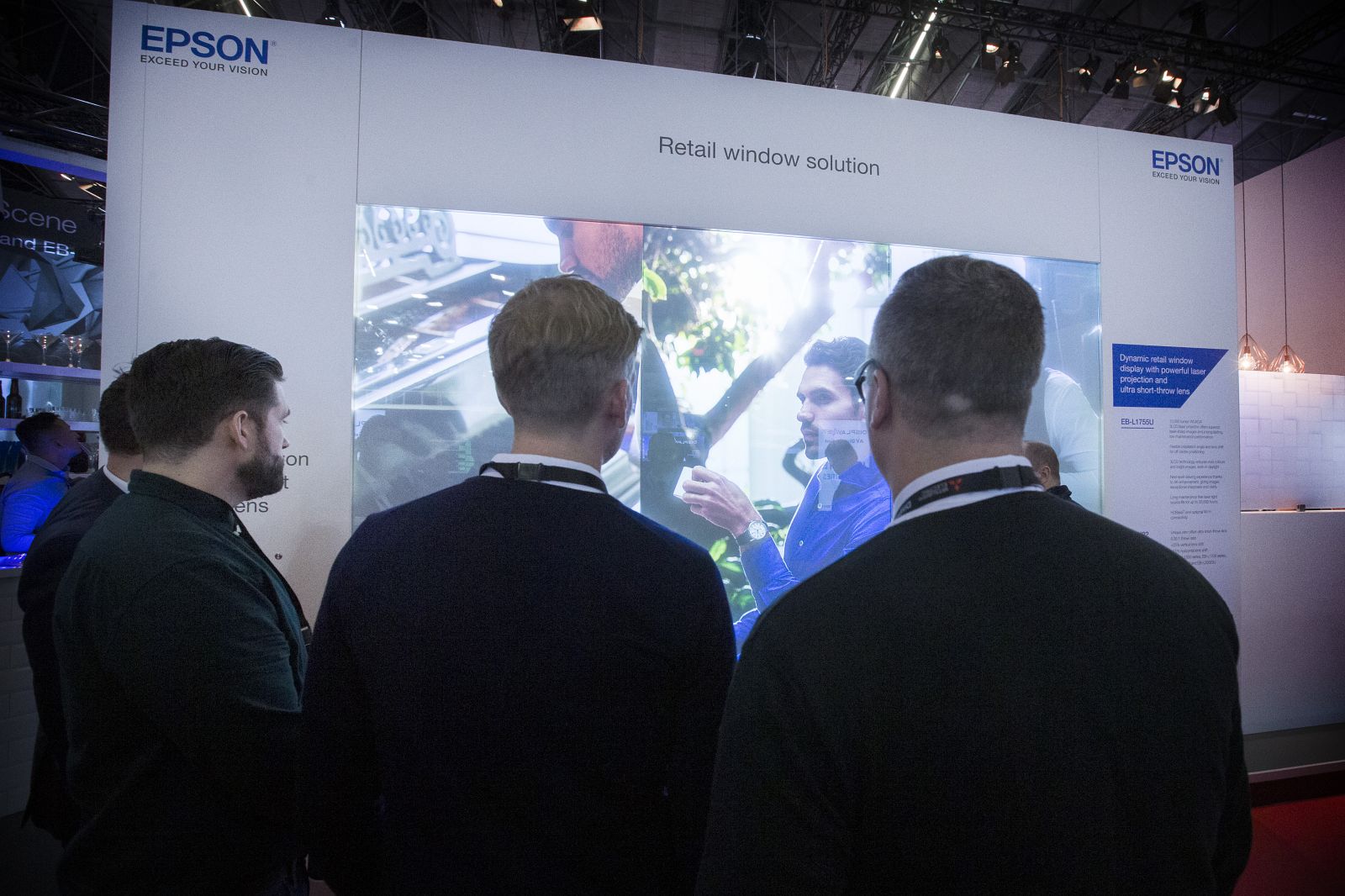
... and outside
Obviously, the whole secret is in a special film pasted on the window, which allows the surface to switch from transparent to matte translucent. See how it looked, you can in this report on YouTube . It looks very cool and futuristic.
In this installation, an ultrashort-focus lens with zero offset was used (i.e., the upper edge of the image was located at the center of the lens).
Spectacular spotlight with Epson LightScene EV-100
The zone, located near the showcase, “distinguished” with other interesting projection options: there was a bar counter with a projection that responds to hand movement (Kinect camera + Epson LightScene EV-100 laser spotlight), there was a lot of bright and accurate projection on small exhibits, among which the following vase stood out:
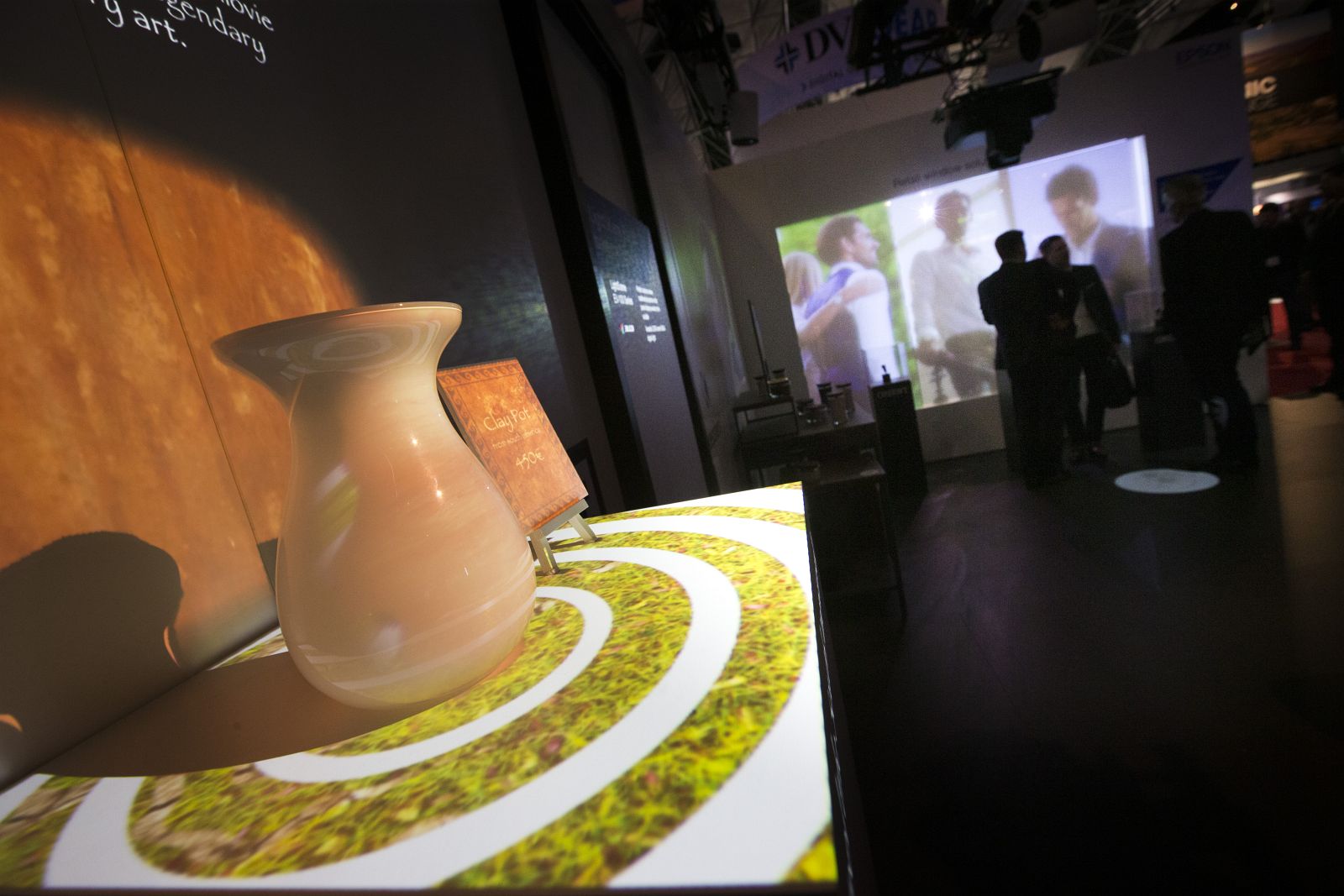
')
Attentive visitors noted that the mapping was configured so that one EV-100 projector simultaneously projected onto: a) the stand surface, b) a vase, c) a plate next to the vase, d) a wall, d) the front surface of the stand, and everything was set up and customized special software.
Among the numerous EV-100, the Epson EB-U50 unobtrusive projector sheltered . Gentlemen, this is a new model ! 3600 lumens of brightness, 10,000 hours of lamp operation.
By the way, there is the following observation: in the presence of large screens, the trained eye immediately catches the image projected by one-matrix projectors with peripheral vision (namely, the “rainbow effect”). More precisely, the desire to “check the projection” immediately arises, with a sharp glance from edge to edge. Since All Epson projectors are three - matrix , this feature is not peculiar to them in principle. However, it is worth remembering that in the case of bright installation projectors, DLP-based models can be either one-matrix or three-matrix.
In the latter case, one cannot talk about the advantages of one of the technologies in terms of contrast or color brightness, unless specific models are compared with each other, but one-matrix ones simply cannot fail to show the rainbow effect in one form or another due to the nature of the technology.
Crouching Tiger Hidden Epson EB-L1755U
But back to Epson EB-L1755U, which is so popular at trade shows for a reason - 15000 lumens of color and ANSI brightness in a rather compact package, plus support for 4K (using 4K Enhancement pixel shift technology), built-in cameras, wide lens shift ranges and so forth
This model also has an option in the white case - Epson EB-L1750U, which was used in the third interesting installation, where the projector was “hidden” under the ceiling and projected onto a wall 5 meters wide:

Projects hidden Epson EB-L1750U, on the rack - EB-L1070U (7000 lm) with a UKPL-ELPLX01W lens
Brightness was enough with a margin, and you, of course, noticed that the wall was filled with them from floor to ceiling - all thanks to the UKF-offset offset lens (ELPX02), which is great for museum installations. In addition, outside this corridor, the lighting is stronger, so more powerful projectors shine on the screen already 4 meters wide.
Why turn the projector when there is a mirror?
The fourth curious projection variant, which also involves the use of mirrors to redirect light (after all, UKF lenses shine back ) was used in the solution from the Dynamic Projection Institute. The solution involves installing a motorized rotating mirror head in front of the lens of the projector, allowing you to “move” the final image along the wall without changing the position of the projector.
Theoretically, such a solution significantly benefits from a simple image deployment on the entire wall, which has its limitations related to brightness, clarity (or lack of resolution) and projection distance. In operation, this technology was demonstrated by two Epson EB-L1755U projectors (you can see it in the same video report from ProjectorWorld.ru ).

More means more effective
Several other models were demonstrated on the stand, including Epson EB-L12000Q (12000 Lumen, 4K matrix ), EB-L20000U (20K lumen) and EB-L20002U (the same, but in a white case).
An important event was the prototype of the future “flagship” of the Epson installation line presented at the exhibition, which will replace Epson EB-L25000U in the future. Rather, it will be an evolutionary step - Epson EB-L30000U will have a luminous flux of 30,000 lumens, support standard interface cards that can be updated or transferred from one projector to another , and other improvements.

Epson EB-L30000U Prototype
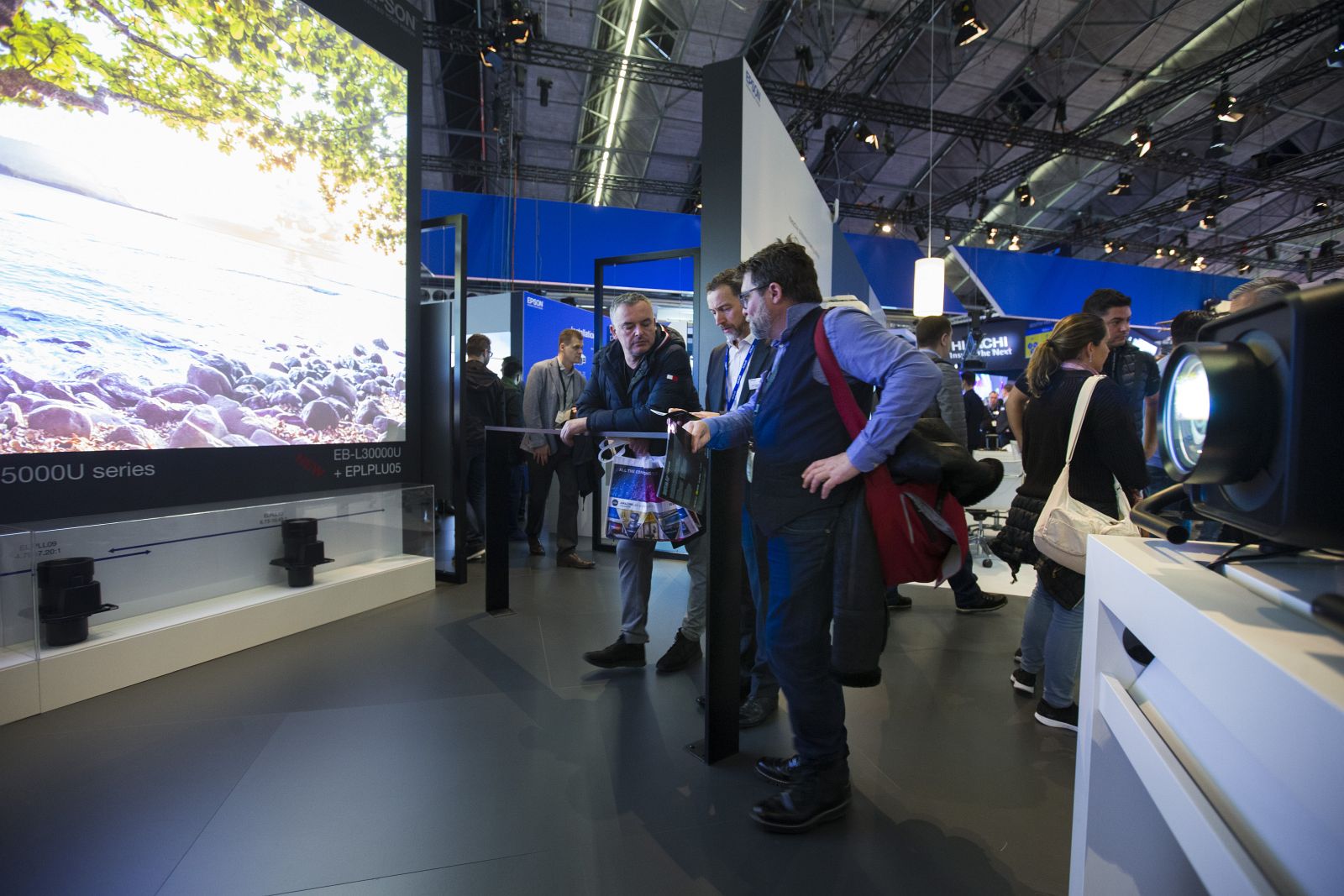
He is. Under the screen in a row were compatible lenses (8 pieces)
Epson EB-L1070U - moderately bright, with interchangeable optics
Another new product is professional projectors for meeting rooms, museums and other premises where brightness from 5500 to 7000 lumens is needed - the Epson EB-L1070U series . These projectors are not only fairly compact for their size, but also compatible with interchangeable lenses, which are used in older models of the EB-L1000 series . For integrators involved in specialized installations, this is very good news.
LAN instead of remote
Concluding the topic of installation projectors, I’ll draw your attention to the fact that a separate exhibit was stitching images from two Epson EB-L1755U, which were controlled over a local network using Epson Projector Professional Tools . Such an option can be much more convenient than setting up a complex projection using remote controls. The stand staff just demonstrated how this software allows you to control all the functions of the projectors from one PC over the network.

Moverio BT-350 video glasses
At the event our binocular video glasses Moverio BT-350 were also shown. Let me remind you that they have installed OLED-displays with excellent contrast instead of LCD displays. The presented solutions for museums used image recognition and three-dimensional objects, including:
- Points recognition of objects with the subsequent “drawing over” of various effects on top of them (for example, tapestries on the walls of the castle);
- Activation of effects at a certain mutual arrangement of objects on the table: put the dragon to the castle - a 3D dragon spewing flame spins over the castle;
- We fall into a space that remotely resembles an ancient city - the “virtual reality” mode is activated. This can be either a 360 ° panoramic view, which responds to head rotation (built-in gyroscope), or the possibility of free movement around a virtual 3D exhibit. In the latter case, “augmented reality” does not work as smoothly as the camera should see the image or object that is used as a marker.
The use of Moverio BT-350 glasses for viewing subtitles (for example, in an opera) was also demonstrated.
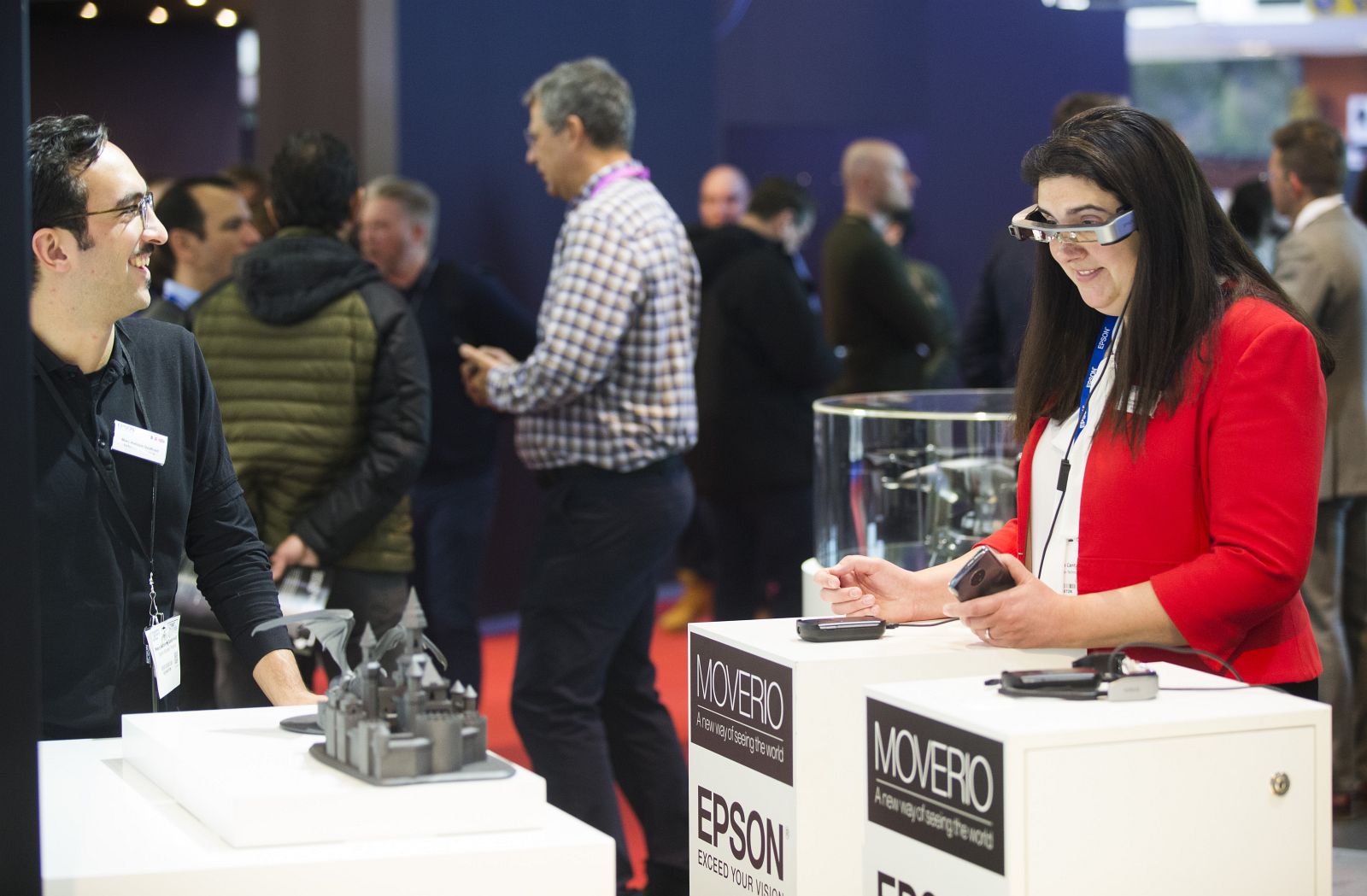
As for the video glasses Moverio BT-35E, which was devoted to the previous blog post , they were also shown. Visitors could see the world through the eyes of an Epson ELPDC21 document camera, a very unusual feeling.
There was also a booth with a quadcopter, which was “teased” by visitors - it was a hint that Moverio glasses are well suited for situations where you need to maintain orientation in space: you can instantly switch attention from the image to the environment without changing the position of the eyes or the direction of gaze . If you want to cope with the bright sun, or when you sit at home and do not want to be distracted by the environment, then the so-called "Dimmers" installed in front of the lenses of glasses.

Laser interactive and ultrashort-focus projectors
Perhaps, I talked about the most interesting thing that was on the Epson booth at ISE 2019. There were other models, but listing each would make the post too tedious.
At the end I will only mention the laser short-focus projectors. Epson EB-1470Ui is a laser interactive projector capable of performing several tasks at once, acting as a stand-alone electronic board, as well as an interactive touch screen with a fast Wi-Fi connection to the user's laptop. And this interesting features of this model are not limited at all!
If the projector does not require “interactive”, but is interested in a long resource of a laser light source and the ability to install in portrait mode, Epson EB-700U will be an interesting option - especially for museums.
Thank you for attention!
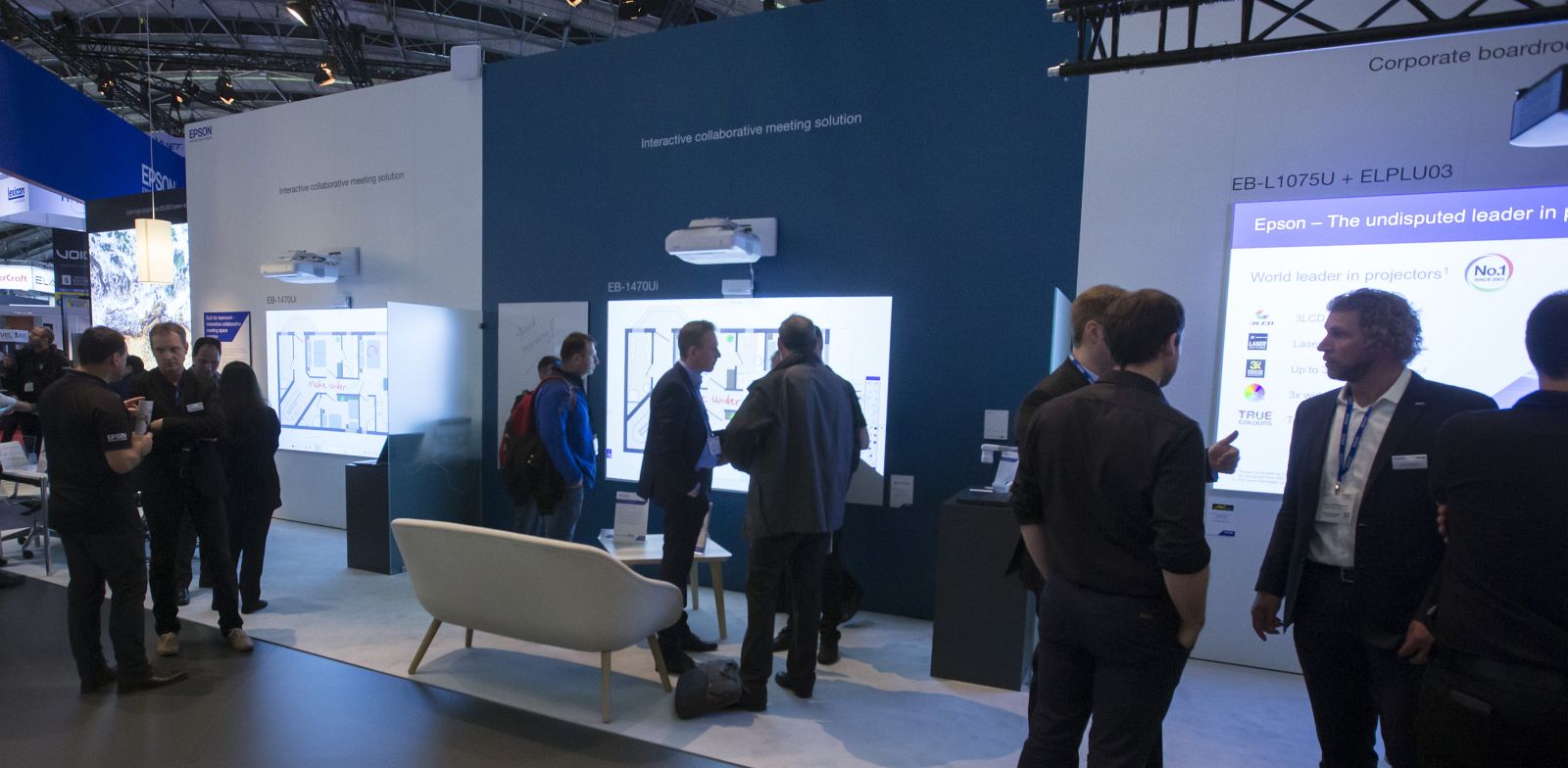
Source: https://habr.com/ru/post/444396/
All Articles